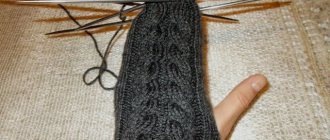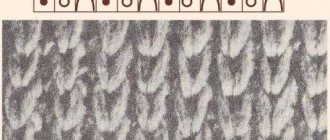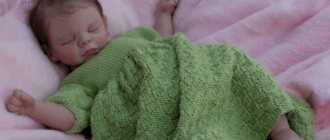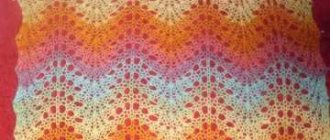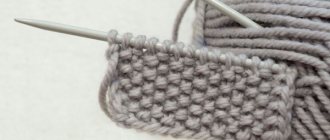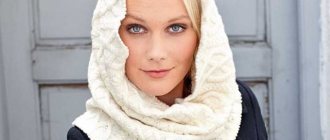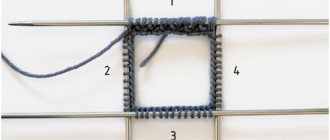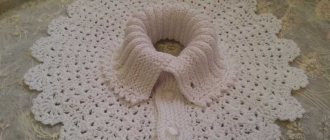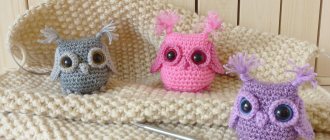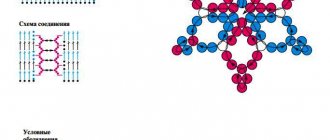How often, when conceiving a new knitted pattern, we start looking for an unusual, sophisticated pattern! But it’s not for nothing that experienced craftsmen recommend starting the path to perfection with simple, but impressively textured patterns. They are excellent for training your arms by adjusting a certain tension by repeating loops over and over again. And the finished knitted fabric, made with a medium-sized creeping pattern, will hide all the flaws if the knitter is still developing mastery. “Corn” is considered one of these universal patterns.
In different sources, this pattern is called differently - “Hedgehogs”, “Knots”, “Scales”, etc., but the different names only emphasize its versatility. In this article we will talk about how to knit the “Corn” pattern with knitting needles and what tools are best to use for this. Let's talk about the composition of the yarn and its optimal thickness.
Features and properties of yarn
Usually they start by choosing the yarn that is most suitable for a particular pattern. This is the basis of such a type of needlework as knitting. The “Corn” pattern is democratic: made from fairly thick threads, it looks no worse than a fabric knitted from traditional medium yarn. But in order to get better at doing it, it is better to start with threads of medium thickness, the footage of which is 250-350 m in a hundred-gram skein.
The composition of the yarn may vary. Acrylic fits well into drawings. It is perfect for baby items, small accessories, handbags, socks, booties and slippers. It is better to knit clothes, especially designer models, from fibers of natural origin - wool, cashmere, merino, and other varieties of wool yarn. Currently, mixed threads are produced, consisting of wool and artificial fibers in various proportions. Wool blend yarn, produced today by many manufacturers, is very popular: good quality is successfully combined with a low price, which makes it affordable and accessible. Adding a stretch component to the thread improves the texture of the pattern and makes the knitted fabric more flexible. In other words, from yarn of any composition you can make a “Corn” pattern with knitting needles. The knitting pattern for this weave is simple, but will require some skill and attention.
Knitting corn on circular knitting needles
Knitting the corn pattern using circular knitting needles slightly changes the appearance of the pattern. So, let's start knitting the first row: knit 1. p., then purl. p. Mark the beginning of the circle for yourself. stripes, since we will not turn the canvas over. New r. similar to the previous one. Above from. the link will be the same buttonhole. Yarn over and slip one off. piece without knitting. This knitting pattern resembles an English rib pattern.
Knit the third strip in the same way as the process was described on straight knitting needles. Purl links should be knitted. method, and the following loop is removed with two throws of yarn. The final r. perform as follows: over faces. p. knit and. p., and links with two crochets are knitted. technology.
Read
Detailed lessons on knitting openwork mittens
As an example, we recommend that you watch an interesting and educational video on knitting the “corn” pattern.
Selecting knitting needles
The most acceptable option for knitting needles for medium thread are sizes 2.5-3. The material from which the knitting needles are made should be light and smooth. An excellent option is a set of wooden, bamboo or Teflon-coated knitting needles. They are lightweight, fit comfortably in the hand, do not create unnecessary inconvenience when working, and have a sliding surface. In addition, these knitting needles, as a rule, are sharpened with high quality and have smooth, but not piercing ends.
Wide fabric is best made on circular knitting needles, the length of which is selected in accordance with the planned width. Line on circular knitting needles does not always meet the expectations of the craftswoman. Today it is being replaced by lightweight, high-quality twisted cords, which are an excellent alternative to knitting needles on a fishing line.
Using ornament
When knitting from medium-thick yarn, the “corn” turns out to be quite small and does not look pretentious, which allows you to experiment with the color of the product. In children's clothing, alternating rows of white and blue, pink, light green and lilac threads, as well as knitting them with melange, that is, yarn whose fibers are colored in several colors, is considered a classic. Due to this, a rainbow effect is achieved without introducing additional threads.
In addition to the usual rows, this technique can also be used to knit simple patterns, which are formed by alternating not different types of loops, but threads of different colors. So, you can use missoni-style colors or knit simple Norwegian stars, the main thing is to take into account the bumpy structure of the “corn” and abandon such patterns, when creating which individual loops scattered throughout the fabric are important.
Clothes for adults open up even greater prospects for the author in using this pattern. The fact is that “corn” is well suited for creating both men’s and women’s products - from mittens to coats. In addition, it goes well with almost all popular patterns: it can be used to connect rows between voluminous arans, alternate in a checkerboard pattern with hedgehogs, or decorate horizontal stripes between herringbones.
Article on the topic: Do-it-yourself little train made from paper and candy: master class with photos
“Corn” is also used when knitting hats - it goes well with any elastic bands. The main thing is to take into account the purpose of creating this or that thing and not to overdo it with patterns in general.
This pattern is one-sided, so it is more suitable for knitting hats, cardigans or shawls. However, the reverse side looks neat, so “corn” is often used to decorate snoods. In the same case, if the scarf or stole knitted using this technique should be smooth from the inside out, according to the author’s idea, the product can be made double-sided. To do this, it is enough to knit a fabric of the same size using stockinette stitch or simple stockinette or garter stitch and connect it with a product decorated with “corn” using a knitted stitch.
Let's get started: features of the drawing
Any handicraft combines ease of execution with a clear understanding of the algorithm of actions. Such a hobby as knitting is no exception. The “Corn” pattern is simple to work with, but you should remember some very important points. The texture of the pattern appears on the reverse side of the knitted fabric. This is a feature of the pattern that must be taken into account if it is used in a fabric that combines several different weaves. To complete the pattern, cast on any even number of stitches on the knitting needles. The typesetting method also does not play a special role - either the most ordinary one, Italian or cross-shaped, will do. So, let's start knitting - the "Corn" pattern. Its scheme is simple and clear.
Let us remind you that edge loops are not included in the calculation, since they do not participate in the pattern, but only decorate the edge of the product: the first of them is always removed without being knitted, and the last one is knitted purl-wise.
First knitting option
The “Corn” knitting pattern is knitted like this. An even number of stitches are cast on the knitting needles. As a rule, Italian or regular loops are used. Each row will consist of purl, knit and yarn over stitches.
First row. In order to get a full-fledged element, you need to remove the outer loop, then knit the front loop behind the front wall. The next stitch is a purl stitch. You need to knit in the same way to the end of the row. The last element should be the purl. The entire row of edging is secured. As a result, this row looks like an elastic band.
Second row. It also starts with the edge. Then - the front loop. The next one is a purl and double crochet. You need to knit this way until the end, and the last stitch will be the edge loop.
Third row. Edge loop. Then yarn over the next stitch and slip. In this case, there is no need to knit on the right needle. To make the second yarn over, you should throw a thread of yarn onto the knitting needle from the outside of the future product. Then make a purl loop. This series should be completed in this order.
Fourth row. It starts, like the previous ones, with an edge loop. Then you need to tie the front one behind the front wall. Now take the next element with two yarn overs and purl it. You have to look very carefully to catch all three threads in this loop. Otherwise there will be a hole in the product.
Fifth row. This will be a repeat of the first one. After every fourth row, you need to repeat the entire knitting.
Clue. This is really interesting knitting. The “Corn” pattern (the diagrams for it are very clear) is not that complicated, you just need to maintain the tension of the yarn thread. It should not be very strong or weak. Also, do not allow the thread to sag. If you do not take these simple rules into account, you will not get a beautiful drawing.
Knitting: "Corn" pattern. Fourth row diagram
1 edge, we knit the first loop behind the front wall, we knit a loop with two crochets purl. This purl is done carefully, picking up all three threads. To make knitting more convenient, you do not need to tighten the thread too much, but it is also not recommended to tighten the fabric: beginner knitters need to monitor the thread tension. It should neither sag nor be overly stretched. As always, the golden mean is appropriate here - a soft medium tension.
From the fifth row the pattern is repeated, i.e. the pattern repeat is four rows. This is how the “Corn” pattern is made with knitting needles. The pattern of this pattern, presented in the article, is so simple that it usually does not raise questions even for novice knitters.
Photo of the process of knitting a “corn” pattern on knitting needles
To knit an ornament correctly, you need to cast on an even number of stitches with knitting needles. We begin to complete the first row from the edge, which we simply remove. Then we knit the faces. p., and behind it purl. Continue this alternation of links until the end of the strip.
Read
Knitting patterns for men with detailed descriptions
Start knitting the next row according to the pattern. In place of persons. p. Accordingly, they knit the same one, where it was. p. must be removed with a double crochet. The last edge stitch is knitted inside out. In the third row, also start working by removing the edge. Then cast the thread onto the right needle and transfer without knitting. Make the second link with a double crochet. After this comes and. p., which is knitted in the front way behind the first wall. Continue similar manipulations until you have completely knitted the strip. The last buttonhole, that is, the edge buttonhole, is knitted from the inside out. After you have completed this row, you will see that the first signs of our “corn” will begin to appear.
On the fourth day Also, first of all, remove the edge, then tie the faces. n. A new loop with two yarn overs is knitted inside out. Continue these manipulations until the very end, not forgetting to do the last one. p. In the last row of rapport, start doing all the manipulations from 1 p.
Video: How to knit corn
Where is the Corn pattern used?
This pattern is a generally accepted pattern for knitting almost all children's things, from hats and booties to suits and blankets. The pearly relief of a medium-sized pattern contributes to its popularity in knitting children's clothing. But this pattern is so universal that it is used in both women's and men's clothing and hats. The knitted “Corn” pattern with knitting needles, the pattern of which is clear, has proven itself to be excellent in the manufacture of the most popular accessories today - scarves and snoods. Today's variety of models with an emphatically textured “corn” pattern, its various interpretations in combination with other patterns, plaits, braids and arans, amazes the imagination and surprises. After all, the drawing is simple, and the possibilities for its use in the design and execution of clothing are endless.
This is the paradox of many crafts - simple techniques give rise to many interesting ideas. This type of needlework, such as knitting, is also in tune with this. The “Corn” pattern is a prime example of this. There is hardly any product that cannot be knitted with this pattern. Used in children's patterns and modern women's and men's knitwear, this pattern has remained in demand and loved for many years.
Scheme of the “Corn” pattern
This pattern is not double-sided, since the back and front sides are different. From the back it looks voluminous and has the appearance of grains, and on the front side it has a smooth structure. Often, it is used with the convex part outward, since from this angle the drawing looks much better and unusual.
Knitting of this pattern is used in sweaters and hats because it holds its shape perfectly and remains soft and pleasant to the touch. Products with such patterns are good to wear in winter, as they retain heat and add volume, maintaining the natural temperature of your body. The corn pattern is also found in home interiors. They knit decorative pillows, blankets and much more.
The drawing diagram is quite simple. Its rapport has four vertical rows, and horizontally it consists of four loops. In the figure you can see what the described circuit looks like:
